Accounting for Stock Transactions
This section demonstrates how to account for stock transactions.
Stock issued for cash
Corporations may issue stock for cash.
Common stock. When a company such as Big City Dwellers issues 5,000 shares of its $1 par value common stock at par for cash, that means the company will receive $5,000 (5,000 shares × $1 per share). The sale of the stock is recorded by increasing (debiting) cash and increasing (crediting) common stock by $5,000.
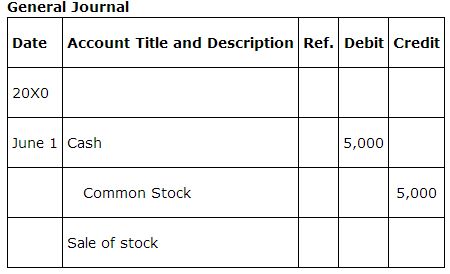
If the Big City Dwellers sold their $1 par value stock for $5 per share, they would receive $25,000 (5,000 shares × $5 per share) and would record the difference between the $5,000 par value of the stock (5,000 shares × $1 par value per share) and the cash received as additional paid‐in‐capital in excess of par value (often called additional paid‐in‐capital).
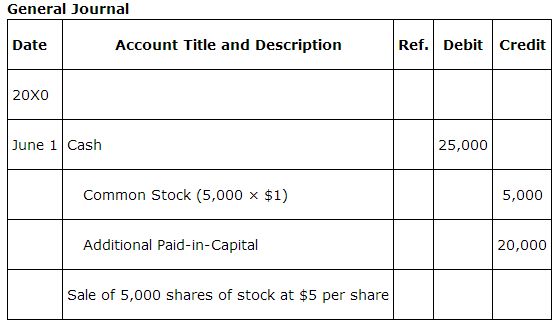
When no‐par value stock is issued and the Board of Directors establishes a stated value for legal purposes, the stated value is treated like the par value when recording the stock transaction. If the Board of Directors has not specified a stated value, the entire amount received when the shares are sold is recorded in the common stock account. If a corporation has both par value and no‐par value common stock, separate common stock accounts must be maintained.
Preferred stock. The sale of preferred stock is accounted for using these same principles. A separate set of accounts should be used for the par value of preferred stock and any additional paid‐in‐capital in excess of par value for preferred stock. Preferred stock may have a call price, which is the amount the “issuing” company could pay to buy back the preferred stock at a specified future date. If Big City Dwellers issued 1,000 shares of its $1 par value preferred stock for $100 per share, the entry to record the sale would increase (debit) cash by $100,000 (1,000 shares × $100 per share), increase (credit) preferred stock by the par value, or $1,000 (1,000 shares × $1 par value), and increase (credit) additional paid‐in‐capital—preferred stock for the difference of $99,000.
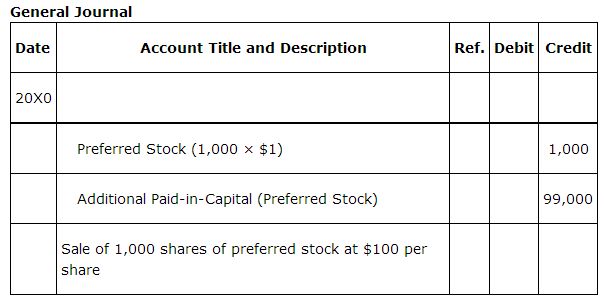
If corporations issue stock in exchange for assets or as payment for services rendered, a value must be assigned using the cost principle. The cost of an asset received in exchange for a corporation's stock is the market value of the stock issued. If the stock's market value is not yet determined (as would occur when a company is just starting), the fair market value of the assets or services received is used to value the transaction. If the total value exceeds the par or stated value of the stock issued, the value in excess of the par or stated value is added to the additional paid‐in‐capital (or paid‐in‐capital in excess of par) account. For example, The J Trio, Inc., a start‐up company, issues 10,000 shares of its $0.50 par value common stock to its attorney in payment of a $50,000 invoice from the attorney for costs incurred by the law firm to help establish the corporation. The entry to record this exchange would be based on the invoice value because the market value for the corporation's stock has not yet been determined. The entry to record the transaction increases (debits) organization costs for $50,000, increases (credits) common stock for $5,000 (10,000 shares × $0.50 par value), and increases (credits) additional paid‐in‐capital for $45,000 (the difference). Organization costs is an intangible asset, included on the balance sheet and amortized over some period not to exceed 40 years.
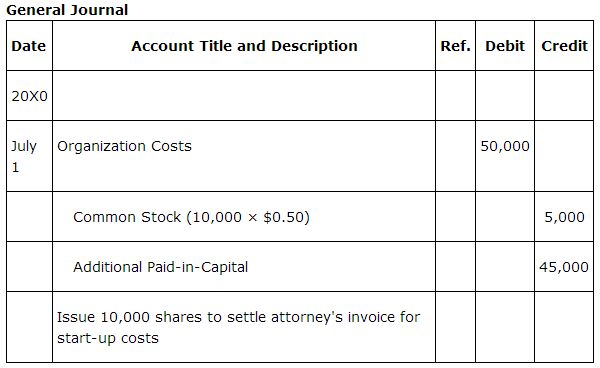
If The J Trio, Inc., an established corporation, issues 10,000 shares of its $1 par value common stock in exchange for land to be used as a plant site, the market value of the stock on the date it is issued is used to value the transaction. The fair market value of the land cannot be objectively determined as it relies on an individual's opinion and therefore, the more objective stock price is used in valuing the land.
The stock transactions discussed here all relate to the initial sale or issuance of stock by The J Trio, Inc. Subsequent transactions between stockholders are not accounted for by The J Trio, Inc. and have no effect on the value of stockholders' equity on the balance sheet. Stockholders' equity is affected only if the corporation issues additional stock or buys back its own stock.
Treasury stock is the corporation's issued stock that has been bought back from the stockholders. As a corporation cannot be its own shareholder, any shares purchased by the corporation are not considered assets of the corporation. Assuming the corporation plans to re‐issue the shares in the future, the shares are held in treasury and reported as a reduction in stockholders' equity in the balance sheet. Shares of treasury stock do not have the right to vote, receive dividends, or receive a liquidation value. Companies purchase treasury stock if shares are needed for employee compensation plans or to acquire another company, and to reduce the number of outstanding shares because the stock is considered a good buy. Purchasing treasury stock may stimulate trading, and without changing net income, will increase earnings per share.
The cost method of accounting for treasury stock records the amount paid to repurchase stock as an increase (debit) to treasury stock and a decrease (credit) to cash. The treasury stock account is a contra account to the other stockholders' equity accounts and therefore, has a debit balance. No distinction is made between the par or stated value of the stock and the premium paid by the company. To illustrate, assume The Soccer Trio Corporation repurchases 15,000 shares of its $1 par value common stock for $25 per share. To record this transaction, treasury stock is increased (debited) by $375,000 (15,000 shares × $25 per share) and cash is decreased (credited) by a corresponding amount. The entry looks like the following:

In the balance sheet, treasury stock is reported as a contra account after retained earnings in the stockholders' equity section. This means the amount reported as treasury stock is subtracted from the other stockholders' equity amounts. Treasury shares are included in the number reported for shares issued but are subtracted from issued shares to determine the number of outstanding shares.
When treasury stock is sold, the accounts used to record the sale depend on whether the treasury stock was sold above or below the cost paid to purchase it. If the treasury stock is sold above its cost, the sale increases (debits) cash for the proceeds received, decreases (credits) treasury stock for the cost paid when the treasury stock was repurchased, and increases (credits) additional paid‐in‐capital—treasury stock for the difference between the selling price and the repurchase price. If Soccer Trio Corporation subsequently sells 7,500 of the shares repurchased for $25 for $28, the entry to record the sale would be as shown:

|
|
|
|
|
|
|
|
|
|
|
|
|
|
|
|
|
|
When the remaining 7,500 shares are sold, the entry to record the sale includes an increase (debit) to cash for the proceeds received, a decrease (credit) to treasury stock for the repurchase price of $25 per share or $187,500, and a decrease (debit) to additional paid‐in‐capital × treasury stock, if the account has a balance, for the difference. If the difference between cash received and the cost of the treasury stock is greater than the additional paid‐in‐capital—treasury stock account, retained earnings is reduced (debited) for the remaining amount after the additional paid‐in‐capita—treasury stock account balance is reduced to zero. If Soccer Trio Corporation sells the remaining 7,500 shares of its treasury stock for $21, the entry to record the sale would be as shown:
|
|
|
|
|
|
|
|
|
|
|
|
|
|
|
|
|
|
|
|
|
|
|
|
|
|
|
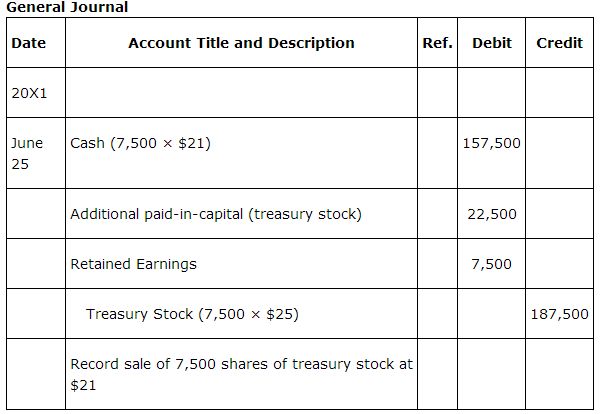
|
|
|
|
|
|
|
|
|
|
|
|
|
|
|
|
|
|
|
|
|
|
|
|
|
|
|
|
|
|
|
|
|
|
|
|
|
|
|
|
|
|
|
|
|
|
|
|
|
|
|
|
|
|
|
|
|
|
|
|
|
|
|
|
|
|
|
|
|
|
|
|
|
|
|
|
|
|
|
|
|
|
|
If the Board of Directors decides to retire the treasury stock at the time it is repurchased, it is cancelled and no longer considered issued. When this occurs, the common stock and additional paid‐in‐capital accounts are decreased (debited) for the amounts recorded in these accounts when the stock was originally issued and cash is decreased (credited) for the amount paid to repurchase the stock. If the repurchase price is more than the original issue price, the difference is a decrease (debit) to the additional paid‐in‐capital—treasury stock account until its balance reaches zero. Once the balance in the additional paid‐in‐capital—treasury stock account reaches zero, or if there is no such account, the difference is a decrease (debit) to retained earnings. If the repurchase price is less than the original selling price, the difference increases (is credited to) the additional paid‐in‐capital account.
|
|
|
|
|
|
|
|
|
|
|
|
|
|
|
|
|
|
|
|
|
|
|
|
|
|
|